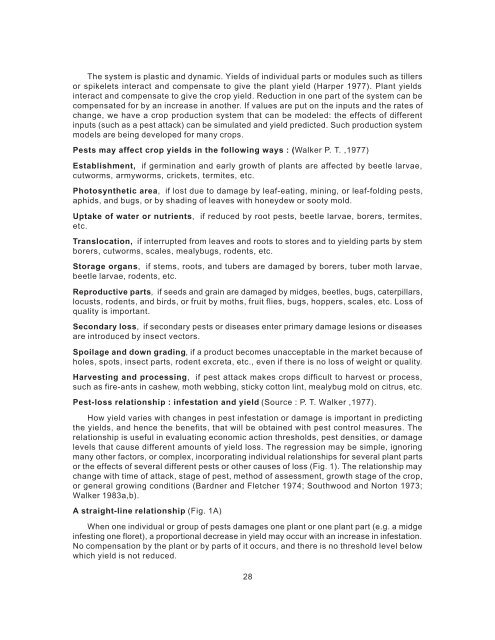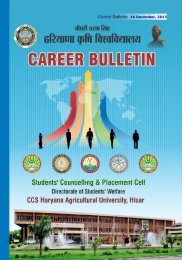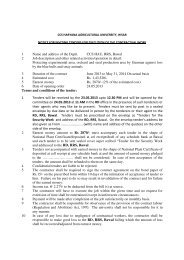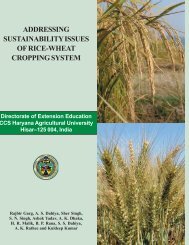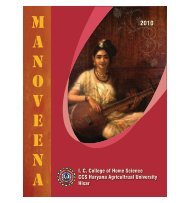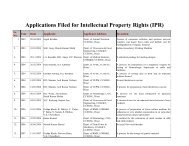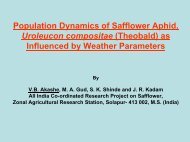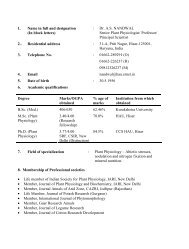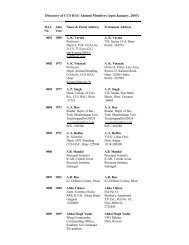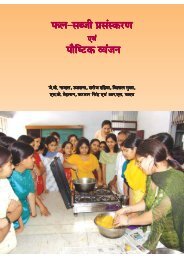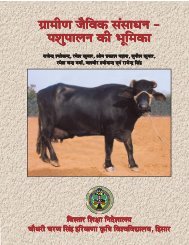Foreword - CCS HAU, Hisar
Foreword - CCS HAU, Hisar
Foreword - CCS HAU, Hisar
You also want an ePaper? Increase the reach of your titles
YUMPU automatically turns print PDFs into web optimized ePapers that Google loves.
The system is plastic and dynamic. Yields of individual parts or modules such as tillers<br />
or spikelets interact and compensate to give the plant yield (Harper 1977). Plant yields<br />
interact and compensate to give the crop yield. Reduction in one part of the system can be<br />
compensated for by an increase in another. If values are put on the inputs and the rates of<br />
change, we have a crop production system that can be modeled: the effects of different<br />
inputs (such as a pest attack) can be simulated and yield predicted. Such production system<br />
models are being developed for many crops.<br />
Pests may affect crop yields in the following ways : (Walker P. T. ,1977)<br />
Establishment, if germination and early growth of plants are affected by beetle larvae,<br />
cutworms, armyworms, crickets, termites, etc.<br />
Photosynthetic area, if lost due to damage by leaf-eating, mining, or leaf-folding pests,<br />
aphids, and bugs, or by shading of leaves with honeydew or sooty mold.<br />
Uptake of water or nutrients, if reduced by root pests, beetle larvae, borers, termites,<br />
etc.<br />
Translocation, if interrupted from leaves and roots to stores and to yielding parts by stem<br />
borers, cutworms, scales, mealybugs, rodents, etc.<br />
Storage organs, if stems, roots, and tubers are damaged by borers, tuber moth larvae,<br />
beetle larvae, rodents, etc.<br />
Reproductive parts, if seeds and grain are damaged by midges, beetles, bugs, caterpillars,<br />
locusts, rodents, and birds, or fruit by moths, fruit flies, bugs, hoppers, scales, etc. Loss of<br />
quality is important.<br />
Secondary loss, if secondary pests or diseases enter primary damage lesions or diseases<br />
are introduced by insect vectors.<br />
Spoilage and down grading, if a product becomes unacceptable in the market because of<br />
holes, spots, insect parts, rodent excreta, etc., even if there is no loss of weight or quality.<br />
Harvesting and processing, if pest attack makes crops difficult to harvest or process,<br />
such as fire-ants in cashew, moth webbing, sticky cotton lint, mealybug mold on citrus, etc.<br />
Pest-loss relationship : infestation and yield (Source : P. T. Walker ,1977).<br />
How yield varies with changes in pest infestation or damage is important in predicting<br />
the yields, and hence the benefits, that will be obtained with pest control measures. The<br />
relationship is useful in evaluating economic action thresholds, pest densities, or damage<br />
levels that cause different amounts of yield loss. The regression may be simple, ignoring<br />
many other factors, or complex, incorporating individual relationships for several plant parts<br />
or the effects of several different pests or other causes of loss (Fig. 1). The relationship may<br />
change with time of attack, stage of pest, method of assessment, growth stage of the crop,<br />
or general growing conditions (Bardner and Fletcher 1974; Southwood and Norton 1973;<br />
Walker 1983a,b).<br />
A straight-line relationship (Fig. 1A)<br />
When one individual or group of pests damages one plant or one plant part (e.g. a midge<br />
infesting one floret), a proportional decrease in yield may occur with an increase in infestation.<br />
No compensation by the plant or by parts of it occurs, and there is no threshold level below<br />
which yield is not reduced.<br />
28


